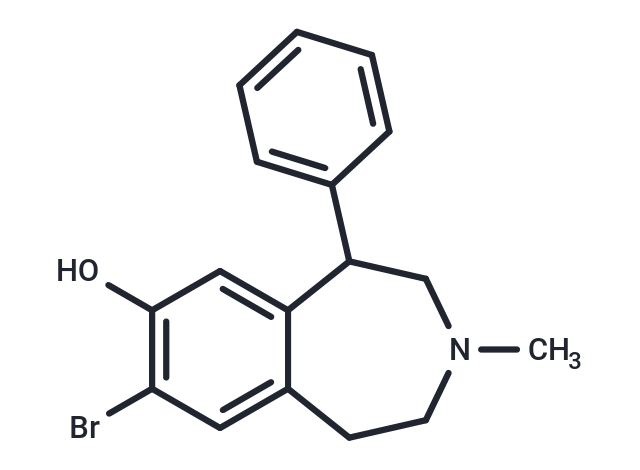Shopping Cart
- Remove All
 Your shopping cart is currently empty
Your shopping cart is currently empty

SKF-83566 is a blood-brain permeable and orally active antagonist of D1-like dopamine receptor and a weaker competitive 5-HT2 receptor antagonist with Ki of 11 nM

| Pack Size | Price | Availability | Quantity |
|---|---|---|---|
| 1 mg | $49 | 5 days | |
| 1 mL x 10 mM (in DMSO) | $83 | In Stock |
| Description | SKF-83566 is a blood-brain permeable and orally active antagonist of D1-like dopamine receptor and a weaker competitive 5-HT2 receptor antagonist with Ki of 11 nM |
| Targets&IC50 | 5-HT2 receptor:11 nM (Ki) |
| In vitro | SKF-83566 caused a concentration-dependent increase in peak single-pulse evoked extracellular DA concentration, with a maximum increase of 65% in 5 μM SKF-83566.?This was accompanied by a concentration-dependent increase in extracellular DA concentration clearance time.?Both effects were occluded by nomifensine (1 μM), a dopamine transporter (DAT) inhibitor, suggesting that SKF-83566 acted via the DAT.?Tested this by examining [(3)H]DA uptake into LLc-PK cells expressing rat DAT, and confirmed that SKF-83566 is a competitive DAT inhibitor with an IC(50) of 5.7 μM.?Binding studies with [(3)H]CFT, a cocaine analog, showed even more potent action of SKF-83566 at the DAT cocaine binding site (IC(50) = 0.51 μM)[1]. |
| In vivo | The facilitation induced by nicotine and cocaine can be blocked by oral administration of the dopamine D1/D5 receptor antagonist (SKF 83566) |
| Molecular Weight | 332.23 |
| Formula | C17H18BrNO |
| Cas No. | 99295-33-7 |
| Smiles | CN1CCc2cc(Br)c(O)cc2C(C1)c1ccccc1 |
| Relative Density. | no data available |
| Storage | store at low temperature | Powder: -20°C for 3 years | In solvent: -80°C for 1 year | Shipping with blue ice. | ||||||||||||||||||||
| Solubility Information | DMSO: 10 mM, Sonication is recommended. | ||||||||||||||||||||
Solution Preparation Table | |||||||||||||||||||||
DMSO
| |||||||||||||||||||||

Copyright © 2015-2025 TargetMol Chemicals Inc. All Rights Reserved.